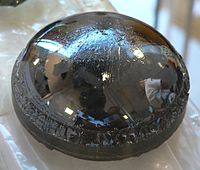
Photo from wikipedia
Abstract The fracture behaviour of (Hf-Ta-Zr-Nb)C high-entropy carbide grains was investigated by microcantilever bending experiments, and fracture related properties (e.g. strength, toughness) were determined using linear beam theory. Microcantilevers were… Click to show full abstract
Abstract The fracture behaviour of (Hf-Ta-Zr-Nb)C high-entropy carbide grains was investigated by microcantilever bending experiments, and fracture related properties (e.g. strength, toughness) were determined using linear beam theory. Microcantilevers were FIB-milled from large grains with {001} and {101} orientations and were subjected to micro-bending experiments. SEM based fractographic analysis of the broken cantilevers revealed that approximately half of them fractured at the fixing position at FIB-induced surface cracks, while the rest of the beams failed at small cracks located at submicron size pores or inclusions. In all cases, fracture occurred on the {001} cleavage plane. The fracture strength of beams fractured at the fixing position was 11.8 ± 0.2 GPa, while the strength of the beams that failed at submicron defects was in the range of 3.8-8.9 GPa. The calculation of stress concentration in the vicinity of pores revealed that local stress field exceeded the value that induced cracking in ‘defect free’ beams.
Journal Title: Journal of The European Ceramic Society
Year Published: 2020
Link to full text (if available)
Share on Social Media: Sign Up to like & get
recommendations!